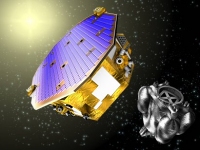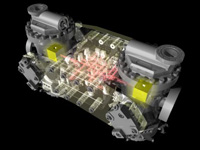Picometre precision demonstrated by LISA Pathfinder tests
21 October 2010
A European team working on the LISA Pathfinder mission has completed an extensive series of ground tests on the spacecraft's optical payload. The tests successfully achieved - for the first time on a spacecraft instrument - the incredible precision that will be required to confirm the existence of gravitational waves.
 |
|
The LISA Pathfinder spacecraft Credit: ESA |
The extremely precise measurements are realised by a laser interferometer that measures the distance between two free-floating heavy masses with reflective surfaces. In the case of LISA Pathfinder, the accuracy of the interferometer measurements is tested by the Optical Metrology Subsystem (OMS; managed, designed, and tested by Astrium GmbH) which comprises several units: a reference laser unit (developed by Tesat, Germany), a laser control unit (by Kayser Threde, Germany) with a laser modulator (developed by RUAG, Switzerland), an optical bench interferometer (built by the University of Glasgow, UK), a phase meter (University of Birmingham, UK), and a data management unit (ICE and NTE, Spain).
The OMS is used to monitor the changes in attitude of two test masses and the distance between them. These two test masses are small, highly polished cubes made of a gold-platinum alloy, situated 35 cm apart, with each located inside a dedicated vacuum enclosure within the satellite.
 |
| Illustration of the LISA Technology Package on LISA Pathfinder which carries the two test masses. Credit: ESA |
Located between these mirrors is an optical bench, on which the optical components are mounted. It is made of Zerodur ceramic glass, which barely expands or contracts when subjected to temperature changes.
For the past two months, a team from Astrium GmbH has been carrying out tests to verify the functionality and performance of the LISA Pathfinder Optical Metrology Subsystem (OMS). The testing was conducted by Astrium at the Max-Planck Institute for Gravitational Physics (Albert Einstein Institute), in Hanover, Germany. Astrium is the industrial architect of the LISA Technology Package (the payload of LISA Pathfinder).
During the tests, light from the Nd:YAG laser is split into two paths, each of which passes through a modulator, or frequency shifter. This alters the frequency of one beam by 1 kHz with respect to the other beam. The beams are then directed to the optical bench.
|
|
|
The optical bench interferometer, a key unit of the OMS. Credit: University of Glasgow and University of Birmingham |
One of the beams is sent directly to a photodetector, while the other beam is directed toward a dummy test mass (in this case, a mirror located off the optical bench). The second beam is reflected back to the optical bench and redirected to a second dummy test mass (another mirror located off the other side of the optical bench). It is finally directed to the same photodetector as the first beam.
Any displacement of the dummy test mass mirrors shows up as a phase change of the interferometer signal detected by the photodetector. The phase change is measured using the phase meter.
"Under stable conditions in space, the motions of the two test masses would be expected to copy each other," said Bengt Johlander, LISA Pathfinder Senior Instrument System Engineer. "However, various external influences, such as magnetic field and electrostatic disturbances, can modify their behaviour."
"Although there are constraints on the ground, caused by temperature variations and vibrations, for example, we try to model the expected behaviour of LISA Pathfinder in space. Although we think we understand the physics, the aim of this campaign was to verify the expected behaviour and stability of the OMS."
During the tests in Hanover, the flight units of the OMS came together with the processing and control software for the first time. They underwent extensive trials, which included checks of the laser interferometry system and verification of tiny displacements between the test masses.
The tests successfully measured the relative distance between the two test mirrors with an accuracy of a few picometres per square root Hertz. (One picometre is about one hundredth the size of a hydrogen atom.) This was equivalent to measuring a variation in the distance between the Earth and the Moon (384 000 km) to within a few millimetres.
The tests also confirmed that the OMS can measure tiny angular shifts of only a few nanoradians. (One nanoradian is approximately the angle subtended by an astronaut's footprint on the Moon as measured from Earth.)
"The requirement for LISA is that the OMS measurement noise (over a frequency bandwidth of 0.001 to 0.03 Hz) is less than 6 picometres per square root Hertz, and we meet that by some margin," said Bengt Johlander.
"It is quite astonishing that measurements of such precision have been achieved," he added. "Although this accuracy has been demonstrated previously in a laboratory environment, we have shown for the first time that it can be incorporated into a space system."
"It is exciting to think that we will be able to measure distance variations of only a few trillionths of a metre between two little cubes that are free-floating in space, with no contact with their surroundings, and at a distance of 1.5 million kilometres from Earth," said Paul McNamara, LISA Pathfinder Project Scientist.
The OMS units are now in the process of being delivered to Astrium's facilities in Stevenage, UK, where they are mounted on the spacecraft and subsequently are electrically and functionally tested to prove their health in the spacecraft environment. The entire spacecraft will begin comprehensive environmental tests next year.
Background
ESA and NASA are working on the development of the Laser Interferometer Space Antenna (LISA), the first space mission dedicated to the detection of gravitational waves. In order to verify that the demanding technologies required for LISA can be achieved, a precursor mission, known as LISA Pathfinder, is under development.
LISA is a constellation of three spacecraft flying in formation, five million km apart. Each spacecraft will carry two test masses that will act as mirrors, reflecting a laser beam emitted by one of the other spacecraft. If a gravitational wave travels through the neighbourhood of the LISA flotilla, the resultant tidal effect is expected to show up as tiny changes in the distances between each pair of independent, free-floating masses.
The main aim of LISA Pathfinder is to demonstrate the concept of low-frequency gravitational wave detection in space. Since the gravitational wave "signal" (also called "ripples in space-time") is caused by the acceleration of massive objects (e.g. black holes mergers), the most interesting frequencies have been calculated to have a period of hundreds of seconds or more. In order to detect such signals, other frequencies must be carefully filtered out. The detection sensitivity is limited by the intrinsic noise of the measurement system in a specific frequency band. For this reason, signal and noise are normally referred to as "spectral density" and all measurement units are specified in "per square root Hertz" at a particular frequency.
Contacts
Bengt Johlander
LISA Pathfinder Senior Instrument System Engineer
Directorate of Science and Robotic Exploration, ESA, The Netherlands
Email: Bengt.Johlander esa.int
esa.int
Phone: + 31 71 5653335
Paul McNamara
LISA Pathfinder Project Scientist
Directorate of Science and Robotic Exploration, ESA, The Netherlands
Email: Paul.McNamara esa.int
esa.int
Phone: +31 71 5658239









